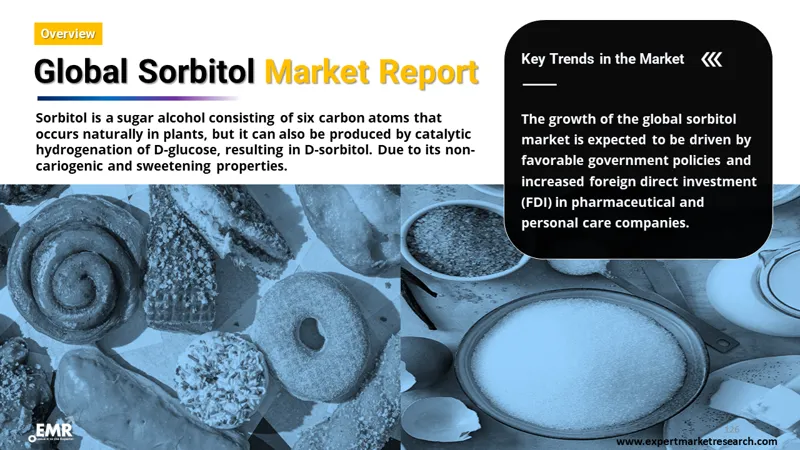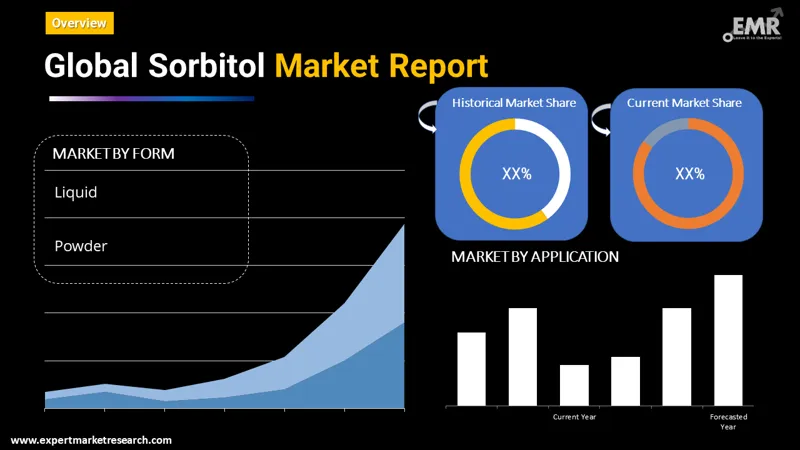
Consumer Insights
Uncover trends and behaviors shaping consumer choices today
Procurement Insights
Optimize your sourcing strategy with key market data
Industry Stats
Stay ahead with the latest trends and market analysis.
The global sorbitol market attained a volume of about 2.78 MMT in 2025. Increasing awareness towards health has led to a greater demand for low-calorie foods which has, in turn, contributed to a steady growth of the global sorbitol market over the past few years. During the forecast period of 2026-2035, the industry is expected to grow at a CAGR of 1.50% to reach 3.23 MMT by 2035.
Base Year
Historical Period
Forecast Period
Skincare products hold a dominant 53% share of the Japanese cosmetics market, according to the International Trade Administration (ITA). This highlights the growing consumer preference for skincare over other cosmetics, driving demand for ingredients like sorbitol, which is commonly used in moisturisers and other skincare formulations.
In 2023, Australia's fast food and takeaway services sector reached a record revenue of USD 23 billion, a USD 2.4 billion increase from the previous year, as reported by the Australian Bureau of Statistics. This growth supports the demand for sorbitol, used in sugar-free products and syrups for the fast-food sector.
Retail sales in cosmetics, toiletries, and medical goods in Singapore grew by 9.4% year-on-year in 2023, according to the Singapore Department of Statistics. This growth reflects the rising demand for beauty products, including those containing sorbitol, as consumers increasingly seek moisturising, sugar-free, and hydrating ingredients in their cosmetics.
Compound Annual Growth Rate
1.5%
Value in MMT
2026-2035
*this image is indicative*
Although a number of feedstock can be used for making sorbitol, the choice of feedstock mainly depends upon the total cost of production and the ease of availability in the region. Corn, cassava and wheat represent the most popular feedstock for sorbitol production.

Read more about this report - REQUEST FREE SAMPLE COPY IN PDF
The sorbitol market is expanding driven by factors such as the increasing demand for sugar substitutes, growth in the personal care and cosmetics sectors, rising pharmaceutical applications, and a strong focus on sustainability and eco-friendly production methods.
With growing awareness around health and wellness, the demand for sugar substitutes like sorbitol is increasing. As people become more concerned about sugar's adverse effects, sorbitol is gaining traction in the food and beverage sectors, particularly in sugar-free and low-calorie options. Offering sweetness without the added calories, sorbitol is a preferred alternative for consumers seeking to reduce sugar intake. In January 2024, Ingredion Ventures supported Israeli startup Better Juice's technology, which reduces sugars in juices, incorporating sorbitol for enhanced sugar reduction.
Sorbitol is becoming a key ingredient in personal care and cosmetic products due to its moisture-retaining and stabilising abilities. It's commonly found in items like moisturisers, shampoos, and toothpaste, improving texture and hydration. The increasing consumer preference for natural, multifunctional ingredients in beauty and skincare is driving sorbitol's adoption. In May 2024, Escentric Molecules launched a body collection enriched with natural oils such as squalane, jojoba, and sorbitol, offering lasting hydration while featuring fragrances like Escentric 01, 02, 03, 04, and 05.
Sorbitol is expanding its use in the pharmaceutical industry, particularly in the production of oral medications, syrups, and lozenges. Known for its non-toxic properties and stabilising effects, sorbitol is increasingly used as an excipient in sugar-free and low-sugar drugs. The rise in chronic diseases is driving demand for sugar-free medications, offering growth opportunities for sorbitol. In April 2022, Genexa introduced clean acetaminophen products, including Extra Strength and PM versions, which contain sorbitol and other clean ingredients, providing consumers with healthier alternatives in major retail stores like Walmart.
Sustainability is becoming a prominent trend in the sorbitol market, with a focus on environmentally friendly production methods. Manufacturers are adopting renewable resources and green chemistry techniques to make sorbitol in a more eco-conscious manner. With increasing consumer demand and regulatory pressures for sustainable practices, this trend is fueling innovation and growth. In January 2023, Vedas Cure launched Vedas Vitaminerals Plus Syrup, which includes sorbitol syrup alongside vitamins and minerals, supporting overall health and promoting a sustainable, healthy lifestyle.
Sorbitol, a six-carbon sugar alcohol, occurs in plants naturally. It can also be synthesised through catalytic hydrogenation of D-glucose to produce D-sorbitol. Sorbitol has non-cariogenic and sweetening properties due to which it is used in toothpaste and oral care products, beverages, ice-creams, jams, syrups, candies, jellies, etc. It is also used as a laxative.
Market Breakup by Form
Market Breakup by Application
Market Breakup by Region

Read more about this report - REQUEST FREE SAMPLE COPY IN PDF
China was the greatest consumer of sorbitol with almost 40% of the world’s total consumption in 2016. Asia Pacific remained the largest region for sorbitol industry in 2016 with more than half of the global industry share and is likely to maintain this position in years to come due to favourable government policies and greater FDI flows for pharmaceutical and personal care firms in India and China. The sorbitol market in North America and Europe is anticipated to exhibit steady growth in the forecasted years due to the growing home and personal care and food and beverage industry in the region followed by economies such as India, Thailand and Indonesia. Inconsistencies in price and supply of raw materials, side-effects due to over-consumption of sorbitol and international regulations are factors that may hinder the growth of sorbitol industry. A detailed analysis including the price movement and regional market scenario of the sorbitol feedstock such as corn, cassava, wheat, etc. is offered in this report.
The sorbitol market key players specialise in a wide range of sectors, including food, pharmaceuticals, cosmetics, and nutrition. These companies are committed to innovation, sustainability, and delivering high-quality products that enhance global well-being. With a strong focus on sustainability, they aim to promote environmentally responsible practices by using renewable resources and reducing carbon footprints. Their diverse product portfolios include starches, proteins, fibres, and other plant-derived ingredients, supporting industries in creating sustainable, nutritious, and functional products.
Headquartered in Lestrem, France, Roquette Frères was established in 1933. The company is a global leader in plant-based ingredients and solutions, specialising in sectors such as food, pharmaceuticals, and cosmetics. Roquette is committed to innovation, sustainability, and providing high-quality ingredients for various industries worldwide.
Founded in 1865 and headquartered in Minneapolis, United States, Cargill, Incorporated is a global leader in food, agriculture, and industrial sectors. The company focuses on providing essential services and products, including agricultural supply chain solutions, food ingredients, and health and nutrition offerings, aiming to enhance food security and sustainability.
Ingredion Incorporated, established in 1906 and based in Westchester, United States, is a global ingredient solutions provider. Specialising in plant-based ingredients, Ingredion serves industries like food and beverages, pharmaceuticals, and personal care. The company focuses on delivering innovative, sustainable solutions to meet the evolving needs of consumers worldwide.
Headquartered in Chicago, United States, ADM (Archer Daniels Midland Company) was founded in 1902. It is a leading global player in agriculture and food processing, offering products ranging from grain and oilseeds to nutrition and bioenergy solutions. ADM prioritises innovation, sustainability, and the global food supply chain.
*Please note that this is only a partial list; the complete list of key players is available in the full report. Additionally, the list of key players can be customized to better suit your needs.*
Another key player in the sorbitol market report is Merck KGaA among others.
Europe Middle East and Africa Sorbitol Market




*While we strive to always give you current and accurate information, the numbers depicted on the website are indicative and may differ from the actual numbers in the main report. At Expert Market Research, we aim to bring you the latest insights and trends in the market. Using our analyses and forecasts, stakeholders can understand the market dynamics, navigate challenges, and capitalize on opportunities to make data-driven strategic decisions.*
Get in touch with us for a customized solution tailored to your unique requirements and save upto 35%!
The global sorbitol market reached volume of about 2.78 MMT in 2025.
The market is projected to grow at a CAGR of nearly 1.50% in the forecast period of 2026-2035.
By 2035, the market is estimated to attain a volume of 3.23 MMT.
The major drivers of the market include the rising disposable incomes, increasing population, and growing home and personal care and food and beverage industries.
Favourable government policies and greater FDI flows for pharmaceutical and personal care firms are expected to be the key trends guiding the growth of the global sorbitol market.
North America, Europe, the Asia Pacific, Latin America, and the Middle East and Africa are the leading regions in the global sorbitol market, with the Asia Pacific accounting for the largest market share.
The leading forms of the product are categorised into liquid and powder.
The most significant application sectors of the market include pharmaceuticals, toothpaste, food and beverages, cosmetics and toiletries, and industrial surfactants, among others.
The leading players in the global sorbitol market are Roquette Frères, Cargill, Incorporated, Ingredion Incorporated, ADM, and Merck KGaA, among others.
Explore our key highlights of the report and gain a concise overview of key findings, trends, and actionable insights that will empower your strategic decisions.
| REPORT FEATURES | DETAILS |
| Base Year | 2025 |
| Historical Period | 2019-2025 |
| Forecast Period | 2026-2035 |
| Scope of the Report |
Historical and Forecast Trends, Industry Drivers and Constraints, Historical and Forecast Market Analysis by Segment:
|
| Breakup by Form |
|
| Breakup by Application |
|
| Breakup by Region |
|
| Market Dynamics |
|
| Competitive Landscape |
|
| Companies Covered |
|
| Report Price and Purchase Option | Explore our purchase options that are best suited to your resources and industry needs. |
| Delivery Format | Delivered as an attached PDF and Excel through email, with an option of receiving an editable PPT, according to the purchase option. |
Datasheet
One User
USD 2,499
USD 2,249
tax inclusive*
Single User License
One User
USD 3,999
USD 3,599
tax inclusive*
Five User License
Five User
USD 4,999
USD 4,249
tax inclusive*
Corporate License
Unlimited Users
USD 5,999
USD 5,099
tax inclusive*
*Please note that the prices mentioned below are starting prices for each bundle type. Kindly contact our team for further details.*
Flash Bundle
Small Business Bundle
Growth Bundle
Enterprise Bundle
*Please note that the prices mentioned below are starting prices for each bundle type. Kindly contact our team for further details.*
Flash Bundle
Number of Reports: 3
20%
tax inclusive*
Small Business Bundle
Number of Reports: 5
25%
tax inclusive*
Growth Bundle
Number of Reports: 8
30%
tax inclusive*
Enterprise Bundle
Number of Reports: 10
35%
tax inclusive*
How To Order

Select License Type
Choose the right license for your needs and access rights.

Click on ‘Buy Now’
Add the report to your cart with one click and proceed to register.

Select Mode of Payment
Choose a payment option for a secure checkout. You will be redirected accordingly.
Gain insights to stay ahead and seize opportunities.

Get insights & trends for a competitive edge.

Track prices with detailed trend reports.

Analyse trade data for supply chain insights.

Leverage cost reports for smart savings

Enhance supply chain with partnerships.

Connect For More Information
Our expert team of analysts will offer full support and resolve any queries regarding the report, before and after the purchase.
Our expert team of analysts will offer full support and resolve any queries regarding the report, before and after the purchase.
We employ meticulous research methods, blending advanced analytics and expert insights to deliver accurate, actionable industry intelligence, staying ahead of competitors.
Our skilled analysts offer unparalleled competitive advantage with detailed insights on current and emerging markets, ensuring your strategic edge.
We offer an in-depth yet simplified presentation of industry insights and analysis to meet your specific requirements effectively.
Share